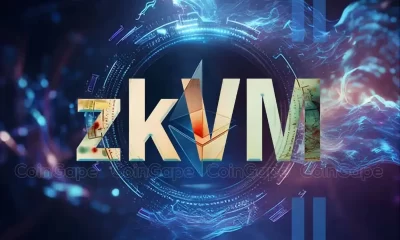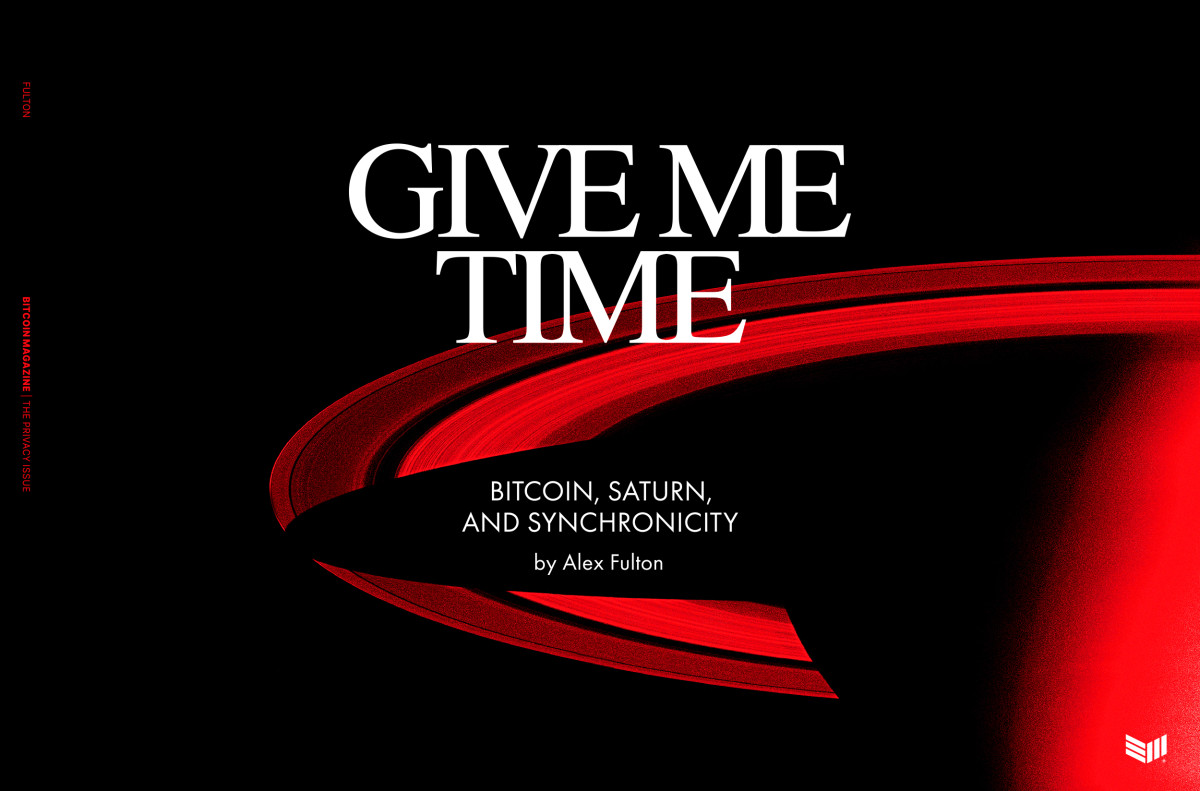Bitcoin Halving
Bitcoin flashes indicator that often precedes higher prices: CryptoQuant
Published
3 months agoon
By
admin

Bitcoin has signaled the end of miner capitulation, as indicated by the popular Hash Ribbons indicator, according to analysts at the on-chain data and analytics platform CryptoQuant.
The analysts’ commentary on the potential for Bitcoin (BTC) to see a fresh surge comes as the flagship cryptocurrency retested the $59k level. However, crypto has struggled over the past week, with BTC price retreating to levels below $60k after hitting resistance at the $62,400 area.
Hash rate hits all-time high
While bears remain a threat, CryptoQuant’s latest post about the possible price scenario for BTC suggests a likely injection of upward momentum in the coming months. The analytics platform notes that the Hash Ribbons, an indicator that traders use to pinpoint “periods of stress in the mining market,” has signaled a potential bottom.
Hash Ribbons signals the end of miner capitulation ⛏️
Hash Ribbons are a popular indicator that highlights periods of stress in the mining market. It uses the 30 and 60-day moving averages of the Hash Rate and has just signaled the end of miner capitulation.
This is logical… pic.twitter.com/pokqp9ccev
— CryptoQuant.com (@cryptoquant_com) August 19, 2024
Hash Ribbons utilize Bitcoin hash rate’s 30 and 60-day moving averages to highlight this likelihood. An end to miner capitulation coincides with the network hash rate surging to an all-time high of 638 exahashes per second.
“Miners are beginning to use more efficient equipment, turning their machines back on and becoming less likely to sell.”
CryptoQuant
Hash Ribbons ‘often’ precedes price rally
Bitcoin had its fourth halving in April 2024, with the block reward reducing from 6.25 BTC to 3.125 BTC. Prices rose ahead of the halving to reach the all-time high above $73,000 before miner capitulation and other negative catalysts pushed BTC lower.
CryptoQuant has pointed to Hash Ribbons flashing – the first since the halving – as a “healthy signal.”
“Although the indicator isn’t meant to pinpoint the exact price bottom, it often precedes higher prices by signaling a reduction in selling pressure from miners.”
CryptoQuant
Bitcoin trades around $59,086 at the time of writing.
Source link
You may like


AI bot transfers $50k in crypto after user manipulates fund handling


Perpetual DEX Hyperliquid to Launch Native Token Following Bullish October


Ethereum Foundation Invests Millions Into zkVM, What’s Happening?


Cardano’s Hoskinson believe Bitcoin will surpass $250,000


BTC AT $97K, XRP Rises 7%, ALGO Surges 23%


Major Bitcoin miners spent $3.6 billion on infrastructure
24/7 Cryptocurrency News
5 Things To Expect from Bitcoin Price Based on Historical Trends
Published
3 months agoon
September 13, 2024By
admin
Historical trends have always been used to analyze Bitcoin price and provide insights into the crypto’s future trajectory. Although these trends don’t always play out the same way, they tend to rhyme and give a pattern, indicating what to expect from the leading crypto. In line with this, there are certain things to expect from BTC heading into the fourth quarter of this year and 2025.
Bitcoin Price To Benefit From Rate Cuts
Bitcoin price is set to benefit from the rate cuts projected to begin at the next FOMC meeting, which will be held between September 17 and 18. Historically, rate cuts by the US Federal Reserve have been considered bullish for BTC since this quantitative easing (QE) leads to an increase in the money supply, with investors having more capital to spend on risk assets like Bitcoin.
The Fed’s last rate cut came in March 2020, marking the beginning of a bull run for the flagship crypto, which rose to an all-time high (ATH) of around $69,000 in November 2021. When the rate cut happened, BTC was trading at around $7,000. As such, something similar could play out again, especially with its price expected to peak by year-end 2025.
Three Consecutive Green Months In Q4
Bitcoin could enjoy three consecutive green months in the last quarter of this year. Coinglass’ data shows that the flagship crypto has historically enjoyed positive monthly returns in October, November, and December in the previous two halving years. This halving event again occurred this year, meaning that the coin could finish the last three months of this year in the green.


Another reason crypto natives are confident that this historical trend could play out this way is how the crypto has performed this month. September has often been bearish for BTC, and this month has been no different. As such, this indicates that Bitcoin price still mimics past trends and could replicate its historical Q4 performance in the 2016 and 2020 halving years.
A Price Rally After The US Elections
A price rally is imminent for BTC after the US elections in November. This happened in the last two presidential elections in 2016 and 2020. Although Bitcoin wasn’t a major talking point ahead of those previous elections like it is now, the certainty that the aftermath of the election brings is constant. Market participants love certainty and will be able to deploy more capital to these risk assets after the election.
It is worth mentioning that experts like Bernstein analysts predict that Bitcoin price will rise to $90,000 if Donald Trump wins the election. However, Steven Lubka, the Head of private clients and family offices at Swan Bitcoin, argues that Bitcoin is rooted in countries’ fiscal and monetary profiles and that the leading crypto will perform positively irrespective of who wins.
Year-End 2025 Could Market Peak For Bitcoin Price
BTC’s price is expected to peak by year-end 2025 based on its halving cycle, which forms part of its four-year cycle. The crypto asset faces two years of bear and bull markets during this four-year cycle. The halving cycle usually marks the start of the bull market, which begins after the halving event. BTC enjoys notable price surges and peaks 16 to 18 months after the halving.
Crypto analyst Rekt Capital’s analysis highlighted how Bitcoin peaked 518 days after the 2016 halving and 546 days after the 2020 halving. If history were to repeat itself, the crypto asset’s price would peak in this cycle in September or October 2025.
The Mars-Vesta Cycle theory, which aligns with Bitcoin’s four-year cycle, also indicates that the market peak for BTC could come in October 2025. Bitcoin price is expected to reach $100,000 by then or even higher.
Massive Price Rally Following Golden Cross
Crypto analyst Titan of Crypto revealed in an X post that a Golden Cross had appeared on Bitcoin’s chart. In past cycles, BTC enjoyed a “massive” price rally whenever this bullish signal appeared on its chart. This indicates that a price surge might be imminent, especially with the rate cuts and given its historical Q4 performance.
Despite Bitcoin having a bullish outlook based on these historical trends, the US economy’s frail state still poses a threat to any price surge BTC is set to enjoy. A short-term or long-term contraction could invalidate these historical trends and lead to a bearish outlook for Bitcoin price. As such, the macro side is still one to keep an eye on.
Boluwatife Adeyemi
Boluwatife Adeyemi is a well-experienced crypto news writer and editor who has covered topics that cut across DeFi, NFTs, smart contracts, and blockchain interoperability, among others. Boluwatife has a knack for simplifying the most technical concepts and making it easy for crypto newbies to understand. Away from writing, Boluwatife is an avid basketball lover and a part-time degen.
Disclaimer: The presented content may include the personal opinion of the author and is subject to market condition. Do your market research before investing in cryptocurrencies. The author or the publication does not hold any responsibility for your personal financial loss.
Source link


This article is featured in Bitcoin Magazine’s “The Privacy Issue”. Subscribe to receive your copy.
With the Fourth Halving in the rearview mirror, it seems a perfect time to provide some on-record analysis of Bitcoin from the perspective of Number and Time, aka Crypto-K, which is the name for a methodology my friend and I have developed over the years in pursuit of a technical analysis of synchronicity — the sense that our reality is arranged according to some as yet undefined acausal ordering principle. The K stands for Kubrick, as in Stanley Kubrick, director of 2001: A Space Odyssey and The Shining, whose life and mysterious works of cinematic art are powerful strange attractors for synchronicity and high strangeness. It is the Monolith around which our methodology — and seemingly everything else — was built.
Most reading this know that Bitcoin is an all-encompassing subject — a rabbit hole. Well, the same goes for Crypto-K, which in some respects is a study of everything, or how everything connects. And that everything includes Bitcoin. So you’re about to find out what happens when one rabbit hole intersects with another.
How is Bitcoin related to Crypto-K?
Both are about Time, or the problem with it. Crypto-K is about asking, “What is the meaning of Time’s Pace?” while Bitcoin is a new spin on the old saying “Time is Money”. How do we protect our MONEY from temporal entropy? On the other hand, how do we protect our TIME from monetary entropy?
All of these concerns fall under the astro-alchemical rubric of Saturn, the seventh classical planet. The planet of laws, boundaries, inheritance, burdens: “the labor of existence, the harvest of time” (Tarnas). Here’s astrologer John Hughes, writing about Saturn: “It is the planet of real worth, as apart from show and make-believe, and gives to all things their permanent and lasting qualities. Its action is slow, thorough and inevitable.” This sounds a lot like the BTC timechain: slow, thorough, and inevitable, defined by its permanence and lasting qualities. Real worth — the labor of existence, the harvest of time, or, in other words, proof of work.
Yes, Satoshi, Bitcoin is Saturnine, all right.
Saturn has a peculiar history when viewed through the lens of fringe theory. In 1980 David Talbott published a book called The Saturn Myth which posited the idea that long ago a previous solar system arrangement had Saturn as the Earth’s primary star, before some terrible calamity occurred that threw everything out of whack.
Maybe Talbott’s theory is whack, but there’s also Richard Hoagland (the “Face on Mars” guy), who has presented theories about Saturn, particularly its moon Iapetus, which he speculated might be an artificial body inhabited by extraterrestrials. It’s possible he regurgitated this from Arthur C. Clarke in the novelized version of 2001: A Space Odyssey, where in that book the climactic Monolith is found buried on Iapetus (not floating by Jupiter as in the film). But forget all that: Even the straight astronomers and scientists, for whom microbes in the dirt would be tremendously exciting, seem to think that Saturn (or rather, one of its moons) is the place to look when it comes to possible life within our solar system.
The point is that your reality tunnel doesn’t matter: Saturn tends to dominate the frame. As the seventh and slowest-moving classical planet, it came to represent the outer limits of material reality itself. As such it was the secret destination of Kubrick’s 2001: A Space Odyssey. The story goes that the special effects team had trouble creating a realistic Saturn, so they pivoted to Jupiter instead. It’s also the secret meaning of the title of Kubrick’s follow-up, A Clockwork Orange. The traditional read on that title is negative, meaning what a human being would become if he lost the ability to choose good over evil — something organic turned false and machine-like, a clockwork orange. It’s a hypothetical state of the human being denigrated under 21st-century pharmacracy. Bitcoin flips this script: What if something which began as a meaningless Saturnine process grew into a truth-affirming juggernaut imbued with analog richness but beyond the reach of any seething sovereign?
Forget “A”. Bitcoin is the clockwork orange.
But why orange?
Bitcoin became the “orange coin” when the logo was finalized by anonymous BTC-talk user “bitboy” on 11/1/10, or the day after the second anniversary of Satoshi Nakamoto’s Bitcoin white paper. He had taken Satoshi’s original idea and cleaned it up, added a 14% twist, and decided to make the whole thing orange. Everyone agreed it was a perfect choice and it has remained in place ever since. The perfect choice of logo met with a perfect release date too, because that date can be reduced to 11110, as in the 1963 executive order issued by President Kennedy to issue silver certificates from the Treasury (occasionally cited by anti-Fed types as the reason JFK was assassinated). Here’s what we call a good old-fashioned sync. It’s possible that bitboy (whoever he was) released the logo on this day intentionally because he recognized the historical pun it would make, but more likely it just kind of happened that way as a grand micro-expression of that general acausal ordering principle mentioned above. It has a pointed sense of humor at times.
Satoshi Nakamoto published the white paper on 10/31/2008 — in other words on Halloween. It’s possible that bitboy had Halloween on his mind when he decided on orange for the logo and released it two years later. Satoshi’s original logo was gold, but that crystallized into orange, perhaps as a way to give Bitcoin its own identity apart from the “shiny rock”. But it was an appropriate move to make from an alchemical perspective. In an essay from The Sync Book Vol. 2 called “Moon in the Middle”, writer Mark LeClair offers a gnostic interpretation of reality (and the color orange) based on a run of 7s: the 7 tones of the diatonic scale, the 7 days of the Gregorian week, and the 7 colors of the rainbow, which all come together to communicate the essential truth of Creation: The Moon is actually the center of everything, the crucified Christ holding reality together. According to LeClair, each day of the week and color correspond to a different planet and stage of the gnostic creation myth. The story begins with the color red and Venus on Friday, then continues to Saturday and Saturn, and of course, the next color on the spectrum, orange. “The color orange is associated with deceit and mistrust, pridefulness and passive assertiveness—a tiger, brimming with orange rage, striped and softly panting, glowering, lurking in the thickness of ferns, ready to pounce and consume the soul from the inside out. The color of gold is also a function of orange, and not of yellow as is the common misconception. Gold is the achievement of royalty and godhead through the act of alchemy, which is a process of Saturn.”
As Ideal Money, true digital gold, the “orange coin” is an achievement in alchemy. The crowning achievement, perhaps, of “Cronos, the designer of Time, the Clockwork Orange… he is tough and resourceful, smart, too dangerous to dismiss as a mere force of blunt or banal evil… Feed him. Give the devil his due. Milk and cookies on the counter should do the trick.”
This imposition to feed the beast might not be unlike the way Bitcoin must be “fed” with more and more electricity to power the global “macro-chip”. Not to compare Bitcoin to the devil or anything, but Satoshi did publish the white paper on All Hallow’s Eve — and wouldn’t you know it, the BTC timechain had been cranking away for exactly 666 days on Halloween 2010, aka the day before the famous orange logo was published.
But there’s another, more spectacular way of connecting Bitcoin to 666 with the calendar. Satoshi gave the public a birth date for himself when he registered with the P2P Foundation: 4/5/1975, also known as the 42nd anniversary of FDR’s EO6102 that unilaterally confiscated U.S. citizen’s private gold holdings. In the late 1980s, there was an issue of The Economist featuring the headline, “Get ready for a world currency” backed by a “Golden Eagle” atop a pile of flaming fiat money (an image much loved by conspiracy theorists over the years). The cover date for this issue was 1/9/1988.
This means that Satoshi Nakamoto was exactly 666 weeks old on the day of The Economist’s “world currency” issue. The magazine came well before Bitcoin ever existed. Did Satoshi know this when he “chose” his birth date?
Does it seem a little threatening to you? Consider the following facts. There are 7 days in one week. This means that in 6 weeks there are 42 days. This means that in 666 weeks there are 42×111 days. Now, 666 is supposed to be a bad number right? But 42 is kind of a funny, happy number, right? So don’t think of Satoshi being 666 weeks old on the day of The Economist’s world currency issue, but instead that he was 4,242 + 420 days old! See, The Book of Revelation designates 666 as the “number of the Beast”. But notice how something as ordinary as the clockface secretly communicates it right in front of you all the time: three overlapping hands — 60 seconds, 60 minutes, 24 (6) hours. The number of the Beast is the number of the Clock. 666 is the Fourth Seal of Crypto-K. The Beast is time, ruled by Saturn. Nothing to be afraid of, though, especially now that we have Bitcoin.
In pursuit of the analysis of synchronicity, we employ what we call the parent-thesis, a dialectical configuration where two points in time (“parents”) generate a third (the “child”) via the exact midpoint between them. Whether it be the midpoint of a person’s life’s or the midpoint between two deaths or two movie releases, it creates a static synchronicity that can be studied and, perhaps, classified. In the case of the birth of Satoshi Nakamoto and the cover date of The Economist world currency issue, the two dates 666 weeks apart generate a midpoint 333 weeks either way of 8/22/1981 — and this happens to be the day that NASA’s Voyager 2 probe made its approach to Iapetus, kicking off its encounter with Saturn. This fly-by first clued astronomers into the existence of the equatorial ridge on Iapetus, which now ranks as the third tallest mountain structure in the entire solar system.
In keeping with the theme, 8/22/1981 also saw the release of a horror B movie called Evilspeak in which Ron Howard’s brother Clint Howard plays a nerd named Stanley Coopersmith (= 237, standard gematria), who stumbles onto the laboratory of a sixteenth-century warlock in the basement of his military academy, then uses his computer skills to summon the Devil in order to enact revenge on the kids who bully him. The opening scene has the bullies calling him “Stanley Cooperdick”, making the Stanley Kubrick comparisons even more obvious. Here we have a Stanley using computer technology to interface with Satan (a kind of artificial intelligence), and commandeering it to do his bidding — in a film released on the day Voyager 2 begins its encounter with Saturn and photographs the moon Iapetus (we’re told) — and on the mid-point of the 666 weeks between Satoshi’s birthday and The Economist’s “get ready for a world currency” issue. As the “clockwork orange”, Bitcoin could be seen metaphorically as a new form of artificial life, a new element “conjured” with computers — a decentralized phoenix rising from the ashes of centralization: Satoshi Nakamoto.
It’s in Douglas Adams’ Hitchhiker’s Guide to the Galaxy that a powerful artificial intelligence in the future is built to answer the question of “life, the universe, and everything”, and comes back after millions of years of processing with the answer 42 — which we call the First Seal of Crypto-K. Satoshi loved 42 and originally wanted the total supply of Bitcoin to be 42 million, but cut it to 21 for economic reasons — then there’s the halving every 210,000 blocks (that’s two halvings per 420,000 blocks). Whether he meant to or not, Satoshi first announced his creation to the P2P Foundation forum on the 42nd day of 2009.
Then there’s also the difficulty adjustment — which some say is Satoshi’s stroke of genius — every 2,016 blocks. Satoshi could have made the adjustment every 2,100 blocks, mirroring the supply cap and halving schedule. Instead, he chose 2,016, a number that was 42 + 42 less than 2,100. There is a mundane explanation for this and then there are several more exciting explanations for this. Was it because 2016 is 6102 — the number of FDR’s gold confiscation order, issued 42 years before Satoshi’s birthday — backward? It could have been because 2016 reduces to 216 which is 6 x 6 x 6 and kabbalistically significant. Or it might simply have been because this made for a difficulty adjustment every 14 days instead of every 14.58333 days. It’s all of the above: Satoshi was carefully synchronizing his creation with the clock and the calendar, i.e., with the movement of the heavens. Thus it naturally fell into the prescribed order of time’s pace, which it is the purview of Crypto-K to analyze and unwind.
Of course, there’s always another sync, and always another opportunity to misinterpret the sync as evidence of conspiracy. Because events occurred in the year 2016 that are indelibly stitched into the timechain of history and retroactively make Satoshi’s choice somewhat conspicuous. Chiefly, it’s 11/9/2016, the election of Donald Trump — the orange man — for U.S. President. But on the inverse date, 9/11/2016, Hillary Clinton appeared to collapse and was tossed like a side of beef into a van that then sped away. It was interpreted by some at the time to have been the effects wrought by 4chan autists and meme-pirates unintentionally invoking an ancient Egyptian frog deity called “Kek”. This then sparked an influential online movement with a food-related name we won’t even mention that subsequently morphed into (or was co-opted by) the Q operation that officially began a year later. Did Satoshi have foreknowledge of the year in which The Plan™ was to begin and encode it into Bitcoin? Probably not, but it was encoded there nonetheless.
Another more salient example of “2016” encoding has to do with the late JFK Jr., who died in a plane crash with his wife on 7/16/1999 — the day on which Stanley Kubrick’s posthumous film Eyes Wide Shut was contractually obligated to be released. JFK Jr.’s death figures heavily into the lore of some Q-adjacent conspiracy merchants, who have lately deployed the narrative that, with his friend Donald Trump’s help, JFK Jr. actually faked his death in 1999 and is set to return when the time is right. Oh boy, where have we ever heard that one before? But that’s not to say there isn’t legit weirdness there, because here’s my point: John-John was born on 11/25/1960 and died on 7/16/1999, which means that his entire life lasted for exactly 2,016 weeks.
If you make John-John’s 2,016-week lifespan a parent-thesis and divide it to find the midpoint, exactly 1,008 weeks into his life was 3/21/1980, the day the TV show Dallas aired its season 3 finale, “A House Divided”, which featured the cliff-hanger death by gunshot of the show’s star J.R. Ewing — one of the most iconic moments in TV history. “Who shot JR on Dallas?” became the question on TV in 1980 in the way that “Who shot JFK in Dallas?” became the question of 1963 — and JFK Jr.’s death occurred such that this episode — a cheeky re-enactment of the Father’s death — aired on the midpoint of the life of the Son.
*If* JFK Jr. faked his death, he apparently did so in such a way that his official fake lifespan silently communicated the future year in which his friend would be elected president, and also pointed to a TV episode referencing his Father’s death. Why the hell would anyone do that, though? Forget the clickbait conspiracy slop. JFK Jr. is dead as a doornail, and more and more it feels like nobody is choosing to do any of this stuff consciously. Again, we are looking at the acausal ordering principle that Carl Gustav Jung discussed in his book Synchronicity — or something along the lines of VALIS, put forth by Philip K. Dick in the wake of his revelatory experiences/temporal lobe seizure which he codenamed 2-3-74. Apparently, different people and events are or can be products of the same underlying operating principle, i.e., VALIS, the salvific entity that is here transforming our world and using us as its implements in doing so.
Orange man, meet orange coin. Is it a match made in heaven? Not so far, though recently the man has softened his tune on the coin after basically denouncing it during his presidency. Here’s what you didn’t know: The orange man’s presidency was inaugurated on 1/20/2017, which was exactly 420 weeks after the orange coin was inaugurated in the Genesis block on 1/3/2009. It would seem that there might be something deeper connecting these two than just the color — after all, Trump isn’t really orange just like Bitcoin isn’t really orange either. In both cases, it’s the brand. Trump’s critics (and his fans) have often remarked how he could shoot someone in broad daylight and get away with it — a hyperbole to emphasize how he resists or repels criticism. In other words, he can survive anything, and can usually spin any negative energy sent his way into a positive outcome. It’s not unlike the way Bitcoiners often say that “everything is good for Bitcoin”. It’s that everlasting Saturnine quality behind both phenomena — or maybe it is just something about the color orange.
If you count the weeks instead from the Bitcoin white paper to Trump’s inauguration it’s 429, which is 666 – 237. This means that 237 weeks before the white paper was 666 weeks before the Trump inauguration, and likewise 666 weeks after the white paper was 237 weeks after Trump’s inauguration. Did Satoshi plan that? Perhaps he did, or perhaps that is only a side-effect of some deeper process unplanned by anyone, what you might call a decentralized signal hidden in the noise.
There are more calendar connections between orange man and orange coin. For instance, Satoshi’s “birthday” on 4/5/1975 was the day after 4/4/1975, when Donald Trump became 1,503 weeks old on the same day Bill Gates and Paul Allen founded their company Microsoft. 153 is the Second Seal of Crypto-K, and one of the most important and mysterious numbers in existence all on its own. Coincidentally or not, this particular span of time — 1,503 weeks — lines up closely with what’s known to astrologers as the Saturn Return, when the planet makes a full orbit and returns to where it was in the sky at birth. This will often coincide with a person’s coming into adulthood in one form or another (a phenomenon known to most people as turning 30). During this period of his life, Donald Trump was embroiled with his father in a lawsuit for civil rights violations.
Actor Heath Ledger who died on 1/22/2008, was born four years after Microsoft (on 4/4/1979), which means he was exactly 1,503 weeks old when he died.
For Trump it was the full legal weight of Uncle Sam that came down on his head — in Ledger’s case, Saturn came home to roost in the form of death by an accidental overdose (or so we are told). According to NASA the actual length of Saturn’s orbit in days is 10,756. The day on which Heath Ledger would have been 10,756 days old was 9/14/2008, aka the 237th day after he died! Let it be known then that this timespan we’re highlighting — 1,503 weeks — is actually 237 days shy of a full orbit of Saturn! 237 is the Third Seal of Crypto-K, spotlighted by Stanley Kubrick in The Shining and, together with 153, they solder the orange man’s Saturn Return to the birth of orange coin creator Satoshi Nakamoto.
So Satoshi Nakamoto was “born” the day after Donald Trump turned 1,503 weeks old (the same day Microsoft was “born”), 42 years after EO6102 — and the Bitcoin Genesis block was mined 420 weeks before Trump took the oath of office.
Then Satoshi registered the website for his incoming digital ledger on 8/18/2008, exactly 210 days after the death of Heath Ledger. This was precisely 1,053 weeks after Donald Trump turned 42.
Donald Trump’s first Monday in office as President — 1/23/2017 — was also what we call his K-Day, or the same age Stanley Kubrick was when he died. The Bitcoin white paper was published 3,006 or 1,503 + 1,503 days before Trump’s K-Day. What makes this truly remarkable is the midpoint: 12/12/2012, the day that someone using the name Nicholas von Saberhagen published the white paper for what would eventually become the privacy-focused cryptocurrency Monero. Some have speculated that there might be a connection between Satoshi and Saberhagen (SN/NS). This information was reported by “MoneroOutreach” in what appears to have been an April Fool’s joke on 4/1/2020. A fact is that Satoshi made his final forum post on 12/12/2010, meaning Saberhagen published the CryptoNote white paper on a two-year “delta” with Satoshi’s final message, not unlike how the orange logo was published only hours after the two-year “delta” of the Satoshi white paper.
Anyone who has read Infinite Jest knows that April Fool’s day can carry serious undertones (especially in spycraft). It would be a mistake to discount this report as totally worthless. The tone seems off somehow, like it’s a joke being told by someone who knows it’s not a joke, but needs it to seem like it is, while also communicating (with no hands) the underlying truth — that Satoshi and Saberhagen were one and the same.
This deliberately paced article mentions three specific dates — two we already know from the first paragraph, and then in the fourth paragraph, “August 13, 2010”, the day of a forum post by Satoshi first referencing the privacy tech that would eventually be implemented into Monero. The magic of this day becomes apparent when you check it against the BTC Genesis block — 42 + 42 weeks apart, meaning it’s also in a 42-week line-up with the Trump inauguration 336 weeks ahead (aka 77 months, 7 days!), which is a remarkable parallel with Bitcoin’s difficulty adjustment every 336 hours. In other words Satoshi’s first mention of ring signatures came 420 – 42 – 42 weeks before the Trump inauguration, similar to the difficulty adjustment every 2,100 – 42 – 42 blocks.
The report from MoneroOutreach on 4/1/2020 was published exactly 20 days, 3 months, and 7 years after the Saberhagen white paper — but further fuel for the conspiratorial fire is that it was also day 1,776 after the death of legendary mathematician John Forbes Nash Jr. and his wife Alicia in a car crash on the New Jersey turnpike on 5/23/2015. John Nash — who you might remember as being played by Russell Crowe in A Beautiful Mind — remains one of the more intriguing under-the-radar candidates for the true identity of Satoshi Nakamoto due to his singular genius in all the requisite fields. Forgetting the Oscar-winning cartoon for a moment, the real John Nash was a visionary-grade cryptologist, mathematician, and game theorist who harbored a lifelong interest in applied economics (not to mention programming and the internet). Late in his life (in the early 2000s) he lectured and wrote on the subject of Ideal Money, and was publicly concerned with countering the mounting effects of decades of inflationary Keynesian monetary policy. We can theoretically surmise that the people in charge of implementing Nash’s ideas from above wouldn’t have been too keen on the concept of ideal money (Bitcoin). In order for it to work it would anyway have had to be released “in a roundabout way” (as Hayek suggested). So was born Satoshi Nakamoto, an alter-ego for a man already haunted by voices — and so went he, out of the window of his taxi, once his managers finally realized what he had done. That’s if you buy the theory, at least.
It’s highly speculative conjecture backed mostly by synchronistic evidence, but hear it out anyway. In Clint Howard’s brother Ron Howard’s 2001 film A Beautiful Mind, John Nash was played by Russell Crowe, while his wife Alicia (in real life an honored native citizen of El Salvador, funnily enough) was played by Jennifer Connelly. In the film we see Connelly/Alicia as a devoted wife standing by her husband as he wrestles with his “demons” while carrying out work he believes he has been singled out to perform by a ‘higher authority’. That film released in December 2001 — but 13 years later the acausal ordering principle struck once more when Crowe and Connelly were cast as husband and wife again, this time in Darren Aronofsky’s 2014 Biblical epic Noah, where we again see Connelly as a devoted wife who stands by her whacko husband as he wrestles with his demons and carries out work he believes he has been singled out to perform by a higher authority. Noah and Nash are a lot alike, are they not?
What work was that again? Oh yes, building the Ark, an engineering project from God to allow humanity and the animals to endure the incoming deluge. Any Bitcoiner worth their salt has already understood the parallel. The orange coin has been referred to as a financial Noah’s Ark on more than one occasion, seemingly engineered (by God, of course) to help humanity stave off an inflationary financial apocalypse, and Nash has emerged (independently) as one candidate for the anonymous builder of that financial Ark. It’s a theory bolstered synchronistically by how the same actors that played Nash and his wife in a Hollywood film, later played Noah and his wife in a Hollywood film about building the Biblical Ark! Again the dichotomy presents itself: Does this represent intentional encoding of media by Hollywood filmmakers and producers, or is it an example of Jung’s acausal ordering principle, where humans can’t help but make certain decisions, telling on ourselves over and over? Good luck getting a consensus on that question.
So, again, the 4/1/2020 report on the Satoshi/Saberhagen matter was published 1,776 days after John Nash and his wife died on 5/23/2015. If there’s anything to compare this to it’s that likewise, Queen Elizabeth’s death on 9/8/2022 arrived 1,776 days after the inaugural Q drop. 1776 was spotlighted by the founding of the USA that year and is the Fifth Seal of Crypto-K, so these are syncs, to be sure, but it’s possible — if however infinitesimally — that all of these items are related on a material level. John Nash remains one of the most convincing candidates for the mantle of Satoshi (even without the Hollywood casting magic) and this April Fool’s dispatch was suspiciously well-timed against his death, which, at this point, might as well be deemed an assassination. It feels like the universe has a secret to tell us, and is using us as its implements to do so.
There’s another temporal tell tying Nash’s possible assassination on 5/23/2015 to Bitcoin: It happened exactly 333 weeks after the Genesis block. In other words, Nash died when the Bitcoin timechain was half of 666 weeks old. If Nash was assassinated for his secret work on Bitcoin, the people who did it would probably go about timing it perfectly according to their secret midnight rituals, and this might be evidence of that — they love their 3s. Or it could be evidence of something else.
Nash died 333 weeks after the Genesis block — so we ask what happened 333 weeks before the Genesis block, or 666 weeks before Nash died? That day is 8/17/2002, a Saturday. The synchronicity that must be remarked on here is how that weekend (Friday, or the beginning of that week, as Mark LeClair would have us believe) a movie was released starring Eddie Murphy called The Adventures of Pluto Nash. Taking place on the Moon in the year 2087, Murphy plays Pluto Nash, an ex-con trying to run a successful lunar nightclub all while evading the lunar mafia. Despite the decent cast, the film was a horrendous bomb, but the universe often uses bombs like these to conceal its deeper truths. Pluto represents Hades, or death itself, so the combination of Pluto and Nash in the title character of a film (in which Nash is being hunted by the “Mafia” who wish to kill him) released 666 weeks before the car crash that killed John Nash and his wife — with the BTC Genesis block at the midpoint. It more than bears mentioning. It’s downright freaky.
Another detail about John Nash that adheres to the architecture of Crypto-K is that he was born in the same year as Stanley Kubrick — 1928. In fact, Nash’s birthday 6/13/1928 and Kubrick’s birthday 7/26/1928 together bracket a span of only 42 days. The Shining received wide release on 6/13/1980, but it premiered three weeks earlier on 5/23/1980, which means that The Shining released on John Nash’s 52nd birthday, while Nash and his wife were car-crashed 35 years after The Shining premiered — 35 years being exactly 420 months, and 52 years being 666 – 42 months. In other words, when a person turns 52, they are one “reign of the Beast” (Rev 13:5) away from 666 months old.
The exact midpoint of John Nash’s life hit on 12/3/71. See it? The 237? Since we’re comparing Nash to Kubrick, we can provide the ready-made knowledge that Kubrick’s life midpoint arrived on 11/15/1963 — one week before the JFK assassination.
Do you want to guess how much time passed from Stanley Kubrick’s midpoint to John Nash’s midpoint?
Exactly 420 weeks. The same length of time as from the Genesis block to the inauguration of Donald Trump! What’s more, the day of Nash’s midpoint — 12/3/71 — was the same day the Polish composer Krzysztof Penderecki premiered his De Natura Sonoris No. 2, music which would later be incorporated by Stanley Kubrick into The Shining! Could this get any more convoluted? Of course, it’s that symmetry thing again, drawing what we call a parent-thesis: Nash’s midpoint arrived 420 weeks after Kubrick’s midpoint, so what happened 420 weeks before Kubrick’s midpoint? You’ll never guess, so it’s 10/28/1955, the birthday of Bill Gates, who has already been mentioned in connection with the founding of Microsoft the day before Satoshi Nakamoto’s “birthday!” Small world, hey?
In A Beautiful Mind, Jennifer Connelly plays a beleaguered wife who, in trying to protect her child, stumbles onto her crazy husband’s papers which prove that he’s schizophrenic. That’s a virtual mirror to The Shining where Shelley Duvall plays a beleaguered wife who, in trying to protect her child, stumbles onto her husband’s private papers which prove that he’s insane. According to Mark LeClair again, Jack Torrance represents Saturn, the demiurge, the “master of time”, an archetype Kubrick also applied to himself via the backstage documentary shot by his daughter Vivian Kubrick, where we see them dressing alike, dramatically typing away at a typewriter, and even hassling “Wendy” — aka Shelley Duvall. Kubrick wanted us to see him squarely equating himself with the character of Jack Torrance — i.e., Saturn. So it would seem that in the year 2001 the character of John Nash in A Beautiful Mind also was overlapped by the same Saturnine trope as Jack and Kubrick in The Shining — and then it happened again with Noah in Noah! It’s almost like the universe (or VALIS) was trying to tell us something, and this is how it speaks.
Nash’s birth brackets 42 days with Kubrick’s birth, and the midpoint of Nash’s life on 12/3/71 came 420 weeks after Kubrick’s life’s midpoint.
So what about the end of their lives?
If you go look it up, you’ll find that Nash died 846 weeks after Kubrick, a figure which amounts to 420 + 420 weeks, plus 42 days.
Who exactly is doing all this, and why?
One person who was verifiably involved in the beginnings of Bitcoin was of course Hal Finney, who was right there to help Satoshi along when the first BTC client launched on 1/9/09, and he was there to receive the first BTC transaction from Satoshi in block 170 on 1/11/09 — which, by the way, occurred exactly 153 + 153 + 153 weeks before the first post from another anonymous internet entity, Q (the 17th letter), on 10/28/2017.
Hal Finney’s birth on 5/4/1956 means that on the day of the Bitcoin Genesis block, he was 19,237 days old. Here we have the Third Seal, 237, combined with what we call the “Ruler” — 19. One property of 19 that remains relevant is how it alphanumerically translates to AI, the abbreviation for artificial intelligence, now positioned as the existential threat of our time. Some Bitcoiners have wildly claimed that BTC represents the counterbalancing force required by nature for humanity to resist AI’s eventual total liquid control of all centralized systems, though none of them have been clear on the specifics of how that might work. But in this regard — BTC vs. AI — the name “Hal Finney” carries certain connotations, because “Hal” is the name of Kubrick’s malevolent AI in 2001: A Space Odyssey: HAL 9000. “Finney” could be read as finis, for finished, as in “HAL finished” — AI finished.
What’s in a name? In this case, perhaps the sum total of a man’s mission on earth.
It was noticed early on that Stanley Kubrick’s death on 3/7/1999 occurred 666 days before 1/1/2001. It took some time for Crypto-K to come along and ask, What happened 666 days before Kubrick died? The answer turned out to be the day that chess grandmaster Gary Kasparov lost a match to the computer Deep Blue, making it the first time that the best human had lost to an artificial intelligence in match-play chess — much the same way that Frank Poole lost to HAL in the film. Compounding the sync is that the computer Deep Blue was built by IBM, and modeled after the Monolith from 2001!
The trope continues to express itself: Man vs. Machine, in a chess match for all the marbles, with history itself the board for the Game of All Time.
Is Bitcoin someone’s idea of checkmate?
Satoshi Nakamoto appeared in digital public for the last time 15 years to the day after Kubrick died — with a message that read “I am not Dorian Nakamoto” — and then exited the stage for good, much like Flight MH370 which disappeared along with Satoshi less than 24 hours later. Satoshi’s final message on 3/7/2014 meant that the total time elapsed from his first published word to his final published word was 279 or 42 + 237 weeks. Hal Finney would find his own end later that year, succumbing to ALS on 8/28/2014, 4,200 hours after Satoshi’s final post — and John and Alicia Nash would be taken less than nine months after that.
His death on 8/28/2014 meant that Hal Finney’s life’s midpoint occurred around 7/1/1985 — a scant 42 hours before the release of Back to the Future, a movie about a plan to use time-travel technology to stop a “terrorist” attack and break a temporal curse.
We know Bitcoin is the clockwork orange, but could it also be the flux capacitor?
Maybe what you’ve read here seems to you like the ravings of a man who has not been properly medicated. But hopefully some shards of this screed will stick in your temporal lobe anyway and in a few weeks or months you’ll be compelled for one reason or another to think about it again, and say, “Huh, maybe that number freak was onto something”. We’ll see.
The Fourth Halving took effect on 4/19/2024, when the BTC timechain was exactly 19 × 42 weeks old — the Ruler (AI) meets the First Seal and the orange coin, a showdown for life, the universe, and everything.
Perhaps Satoshi planned that one ahead of time as well, but even if not, he would have loved how perfectly it all worked out.
Source link
24/7 Cryptocurrency News
Here’s Why Bitcoin Price May Breakout In October 2024
Published
3 months agoon
August 26, 2024By
admin
Following Fed Chair Jerome Powell’s indication of rate cuts in September, the Bitcoin price made strong advancements to $64,000, thereby breaking past its supply zone of $59,000-$62,000. Analysts are expecting a further rally to $70,000 and consequently a new all-time high ahead, however, Bitcoin could see a few weeks of consolidation before this happens.
Bitcoin Price Consolidation
The Bitcoin price has entered nearly six months of consolidation phase marking the longest period it has taken to break past a previous all-time high. However, BTC’s ascent to its all-time high before the Bitcoin halving in April was also the fastest, which shows that the current consolidation phase is well balancing out the earlier rapid price surge.
Popular crypto analyst Rekt Capital highlighted the re-accumulation phase stating that it still isn’t the longest in the cycle. Last year’s re-accumulation in 2023 during the formation of the breakout, lasted for around 224 days.
If historical patterns hold, Bitcoin could break out in October 2024, aligning with the typical post-halving price trends that suggest a potential breakout in late September 2024, noted Rekt Capital.
Bitcoin has been consolidating for almost 6 months
But this current ReAccumulation Range isn’t even the longest one in this cycle
From formation to breakout, the 2023 ReAccumulation lasted longer at 224 days
If history were to repeat, then Bitcoin would breakout in… https://t.co/nbVk8hAzj2 pic.twitter.com/FCaantr3zX
— Rekt Capital (@rektcapital) August 25, 2024
The inflows into spot Bitcoin ETFs also picked up pace following Powell’s rate cut hints suggesting that institutional participation in Bitcoin is once again gaining speed. Analysts at QCP Capital believe that the BTC price will continue to hover in the $61k to $70k range as the markets will wait for key indicators such as the US PCE inflation data as well as the US initial jobless claims for the week.
Furthermore, the market has been rallying on the expectations of the rate cut while restoring investor confidence as implied volatilities (IVs) continue to decline across all major terms.
BTC Open Interest Data
Following the move on Friday, the Bitcoin open interest hasn’t surged significantly in comparison to the previous instances. This shows the reduced risk of immediate full retrace since there are less number of long positions to squeeze out at the moment.
However, it will be important for the bulls to maintain the momentum ahead this week as the key level to hold is the previous local high of $62,800.
#Bitcoin Friday’s move didn’t elevate Open Interest as much as it had done in the past.
Makes this less susceptable to one of those instant full retraces as there’s less longs to squeeze out.
Still, I think it’s key to hold on to the previous local high at ~$62.8K to keep the… pic.twitter.com/IZ3Hxxcjlz
— Daan Crypto Trades (@DaanCrypto) August 25, 2024
Bhushan Akolkar
Bhushan is a FinTech enthusiast and holds a good flair in understanding financial markets. His interest in economics and finance draw his attention towards the new emerging Blockchain Technology and Cryptocurrency markets. He is continuously in a learning process and keeps himself motivated by sharing his acquired knowledge. In free time he reads thriller fictions novels and sometimes explore his culinary skills.
Disclaimer: The presented content may include the personal opinion of the author and is subject to market condition. Do your market research before investing in cryptocurrencies. The author or the publication does not hold any responsibility for your personal financial loss.
Source link

AI bot transfers $50k in crypto after user manipulates fund handling

Perpetual DEX Hyperliquid to Launch Native Token Following Bullish October

Ethereum Foundation Invests Millions Into zkVM, What’s Happening?

Cardano’s Hoskinson believe Bitcoin will surpass $250,000

BTC AT $97K, XRP Rises 7%, ALGO Surges 23%
Why Financial Advisors Must Adapt to Crypto or Risk Losing High-Net-Worth Clients

Major Bitcoin miners spent $3.6 billion on infrastructure

John Deaton Calls For Probe Into Operation Chokepoint 2.0

Solana whales back this new crypto as analysts predict 5,000% surge

Swiss Canton Bern Passes Bill To Probe Impact of Bitcoin Mining

Swiss lawmakers to study Bitcoin for power grid upgrade

Bitcoin Could Reach up to $500,000 Within 24 Months, Says Cardano Founder Charles Hoskinson – Here’s Why

Why Is The Worldcoin Price Up 20% Today, Rally To Continue?

Bybit x Block Scholes report

How High Can Shiba Inu Price Climb If Bitcoin Hits $100,000?
182267361726451435

Why Did Trump Change His Mind on Bitcoin?

Top Crypto News Headlines of The Week

New U.S. president must bring clarity to crypto regulation, analyst says

Ethereum, Solana touch key levels as Bitcoin spikes

Bitcoin Open-Source Development Takes The Stage In Nashville

Will XRP Price Defend $0.5 Support If SEC Decides to Appeal?

Bitcoin 20% Surge In 3 Weeks Teases Record-Breaking Potential

Ethereum Crash A Buying Opportunity? This Whale Thinks So

Shiba Inu Price Slips 4% as 3500% Burn Rate Surge Fails to Halt Correction

‘Hamster Kombat’ Airdrop Delayed as Pre-Market Trading for Telegram Game Expands

Washington financial watchdog warns of scam involving fake crypto ‘professors’

Citigroup Executive Steps Down To Explore Crypto
Mostbet Güvenilir Mi – Casino Bonus 2024

Bitcoin flashes indicator that often precedes higher prices: CryptoQuant
Trending

 2 months ago
2 months ago182267361726451435

 Donald Trump4 months ago
Donald Trump4 months agoWhy Did Trump Change His Mind on Bitcoin?

 24/7 Cryptocurrency News3 months ago
24/7 Cryptocurrency News3 months agoTop Crypto News Headlines of The Week

 News3 months ago
News3 months agoNew U.S. president must bring clarity to crypto regulation, analyst says

 Bitcoin4 months ago
Bitcoin4 months agoEthereum, Solana touch key levels as Bitcoin spikes

 Opinion4 months ago
Opinion4 months agoBitcoin Open-Source Development Takes The Stage In Nashville

 Price analysis4 months ago
Price analysis4 months agoWill XRP Price Defend $0.5 Support If SEC Decides to Appeal?

 Bitcoin4 months ago
Bitcoin4 months agoBitcoin 20% Surge In 3 Weeks Teases Record-Breaking Potential





✓ Share: